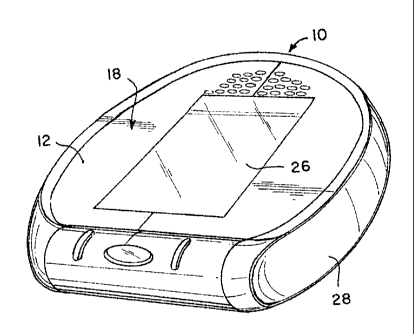Some of the information on this Web page has been provided by external sources. The Government of Canada is not responsible for the accuracy, reliability or currency of the information supplied by external sources. Users wishing to rely upon this information should consult directly with the source of the information. Content provided by external sources is not subject to official languages, privacy and accessibility requirements.
Any discrepancies in the text and image of the Claims and Abstract are due to differing posting times. Text of the Claims and Abstract are posted:
| (12) Patent: | (11) CA 2538638 |
|---|---|
| (54) English Title: | CONTROL UNIT HAVING A DEPLOYABLE ANTENNA |
| (54) French Title: | BLOC DE COMMANDE A ANTENNE DEPLOYABLE |
| Status: | Deemed expired |
| (51) International Patent Classification (IPC): |
|
|---|---|
| (72) Inventors : |
|
| (73) Owners : |
|
| (71) Applicants : |
|
| (74) Agent: | NORTON ROSE FULBRIGHT CANADA LLP/S.E.N.C.R.L., S.R.L. |
| (74) Associate agent: | |
| (45) Issued: | 2014-11-25 |
| (22) Filed Date: | 2006-03-01 |
| (41) Open to Public Inspection: | 2006-09-03 |
| Examination requested: | 2011-03-01 |
| Availability of licence: | N/A |
| (25) Language of filing: | English |
| Patent Cooperation Treaty (PCT): | No |
|---|
| (30) Application Priority Data: | ||||||
|---|---|---|---|---|---|---|
|
A control unit for an implantable medical device includes a housing and electronics within the housing. The electronics control an RF emission from the control unit. An antenna is pivotably connected to the housing. The antenna is movable between a stowed position where RF emission from the antenna is prevented and a deployed position where RF emission from the antenna is permitted. To use the external control unit to effect communication between an external control unit and an implanted medical device, the user places the external control unit within electronic communication range of the implanted medical device. The control unit antenna is moved from the stowed position to a deployed position where RF emission from the antenna is permitted. RF waves are emitted from the antenna to establish communication between the external control unit and the implanted medical device.
Un bloc de commande pour un dispositif médical implantable comprend un boîtier et une électronique dans le boîtier. Lélectronique commande une émission RF à partir du bloc de commande. Une antenne est reliée de manière pivotante au boîtier. Lantenne est mobile entre une position arrimée où lémission RF de lantenne est empêchée et une position déployée où lémission RF de lantenne est permise. Pour utiliser le bloc de commande externe pour établir une communication entre un bloc de commande externe et un dispositif médical implanté, lutilisateur place le bloc de commande externe à portée de communication électronique du dispositif médical implanté. Lantenne du bloc de commande est déplacée de la position repliée à une position déployée où lémission RF de lantenne est permise. Lantenne émet des ondes RF pour établir une communication entre le bloc de commande externe et le dispositif médical implanté.
Note: Claims are shown in the official language in which they were submitted.
Note: Descriptions are shown in the official language in which they were submitted.

For a clearer understanding of the status of the application/patent presented on this page, the site Disclaimer , as well as the definitions for Patent , Administrative Status , Maintenance Fee and Payment History should be consulted.
| Title | Date |
|---|---|
| Forecasted Issue Date | 2014-11-25 |
| (22) Filed | 2006-03-01 |
| (41) Open to Public Inspection | 2006-09-03 |
| Examination Requested | 2011-03-01 |
| (45) Issued | 2014-11-25 |
| Deemed Expired | 2021-03-01 |
There is no abandonment history.
| Fee Type | Anniversary Year | Due Date | Amount Paid | Paid Date |
|---|---|---|---|---|
| Registration of a document - section 124 | $100.00 | 2006-03-01 | ||
| Application Fee | $400.00 | 2006-03-01 | ||
| Maintenance Fee - Application - New Act | 2 | 2008-03-03 | $100.00 | 2008-02-13 |
| Maintenance Fee - Application - New Act | 3 | 2009-03-02 | $100.00 | 2009-02-16 |
| Maintenance Fee - Application - New Act | 4 | 2010-03-01 | $100.00 | 2010-02-15 |
| Maintenance Fee - Application - New Act | 5 | 2011-03-01 | $200.00 | 2011-02-11 |
| Request for Examination | $800.00 | 2011-03-01 | ||
| Maintenance Fee - Application - New Act | 6 | 2012-03-01 | $200.00 | 2012-02-06 |
| Maintenance Fee - Application - New Act | 7 | 2013-03-01 | $200.00 | 2013-02-07 |
| Maintenance Fee - Application - New Act | 8 | 2014-03-03 | $200.00 | 2014-02-05 |
| Final Fee | $300.00 | 2014-08-08 | ||
| Maintenance Fee - Patent - New Act | 9 | 2015-03-02 | $200.00 | 2015-02-04 |
| Maintenance Fee - Patent - New Act | 10 | 2016-03-01 | $250.00 | 2016-02-10 |
| Maintenance Fee - Patent - New Act | 11 | 2017-03-01 | $250.00 | 2017-02-08 |
| Maintenance Fee - Patent - New Act | 12 | 2018-03-01 | $250.00 | 2018-02-07 |
| Maintenance Fee - Patent - New Act | 13 | 2019-03-01 | $250.00 | 2019-02-07 |
| Maintenance Fee - Patent - New Act | 14 | 2020-03-02 | $250.00 | 2020-02-05 |
Note: Records showing the ownership history in alphabetical order.
| Current Owners on Record |
|---|
| CODMAN NEURO SCIENCES SARL |
| Past Owners on Record |
|---|
| GINGGEN, ALEC |
| PIPOZ, THIERRY |